In the intricate tapestry of nature, one of the most fascinating phenomena is animal migration. Each year, millions of creatures embark on epic journeys across vast distances, navigating oceans, deserts, and mountains with remarkable precision. From tiny insects to majestic mammals, the instinctual urge to migrate drives species to undertake these incredible odysseys. But what compels them to embark on such arduous voyages, and how do they navigate across seemingly insurmountable obstacles? Join me on a journey as we unravel the mysteries of Katze migration.
The Drive to Migrate: Migration is driven by a myriad of factors, primarily centered around survival and reproduction. Animals migrate to find better feeding grounds, suitable breeding sites, or to escape harsh weather conditions. The urge to mate and raise offspring also plays a significant role in triggering migratory behavior. For some species, such as the Arctic Tern, migration is a necessary response to the changing seasons, as they follow the rhythm of the Earth’s tilt to maximize their chances of survival.
Navigating the Unknown: One of the most perplexing aspects of animal migration is navigation. How do creatures, some of which weigh mere grams, manage to traverse thousands of kilometers with pinpoint accuracy? Scientists believe that migratory animals employ a combination of innate biological mechanisms and environmental cues to navigate their way across vast distances. These cues may include the Earth’s magnetic field, celestial landmarks, and even olfactory signals. For example, monarch butterflies use a combination of the position of the sun and magnetic fields to guide their migration thousands of kilometers from North America to Mexico.
Epic Journeys: The diversity of migratory patterns in the animal kingdom is staggering. From the epic migrations of wildebeest in the Serengeti to the awe-inspiring journey of humpback whales across oceans, each migration is a testament to the resilience and adaptability of these creatures. Some species, like the bar-tailed godwit, undertake non-stop flights spanning thousands of kilometers, while others, such as the caribou, form vast herds that move across entire continents in search of food and water.
Challenges and Conservation: Despite their remarkable abilities, migratory animals face a myriad of challenges in the modern world. Habitat loss, climate change, pollution, and human development all pose significant threats to migratory routes and stopover sites. Conservation efforts aimed at protecting these critical habitats are essential to ensuring the survival of migratory species. Collaborative initiatives, such as the Migratory Bird Treaty Act and the Convention on Migratory Species, are instrumental in fostering international cooperation to address these challenges.
Conclusion: In unraveling the mysteries of animal migration, we gain a deeper appreciation for the intricacies of the natural world. From the smallest songbird to the largest marine mammal, each migration is a marvel of evolution and adaptation.
